Finance for International Business: Investment Analysis Report
VerifiedAdded on 2022/09/09
|9
|2165
|9
Report
AI Summary
This report analyzes the business proposal of Hatfield Manufacturing Systems plc, an engineering firm specializing in 3D printing, to expand its operations by investing in a new plant in Turkey. The report examines the financial feasibility of the investment, considering factors such as government support, infrastructure, skilled workforce, and lower labor costs in Turkey. It utilizes investment appraisal techniques, including Net Present Value (NPV) and Internal Rate of Return (IRR), to evaluate the project's profitability, with positive results indicating a favorable long-term outlook. The report also assesses the Weighted Average Cost of Capital (WACC) and addresses foreign exchange risks associated with international investment, suggesting hedging strategies to mitigate potential losses. The conclusion supports the expansion plan, emphasizing the need for effective risk management to ensure project success.
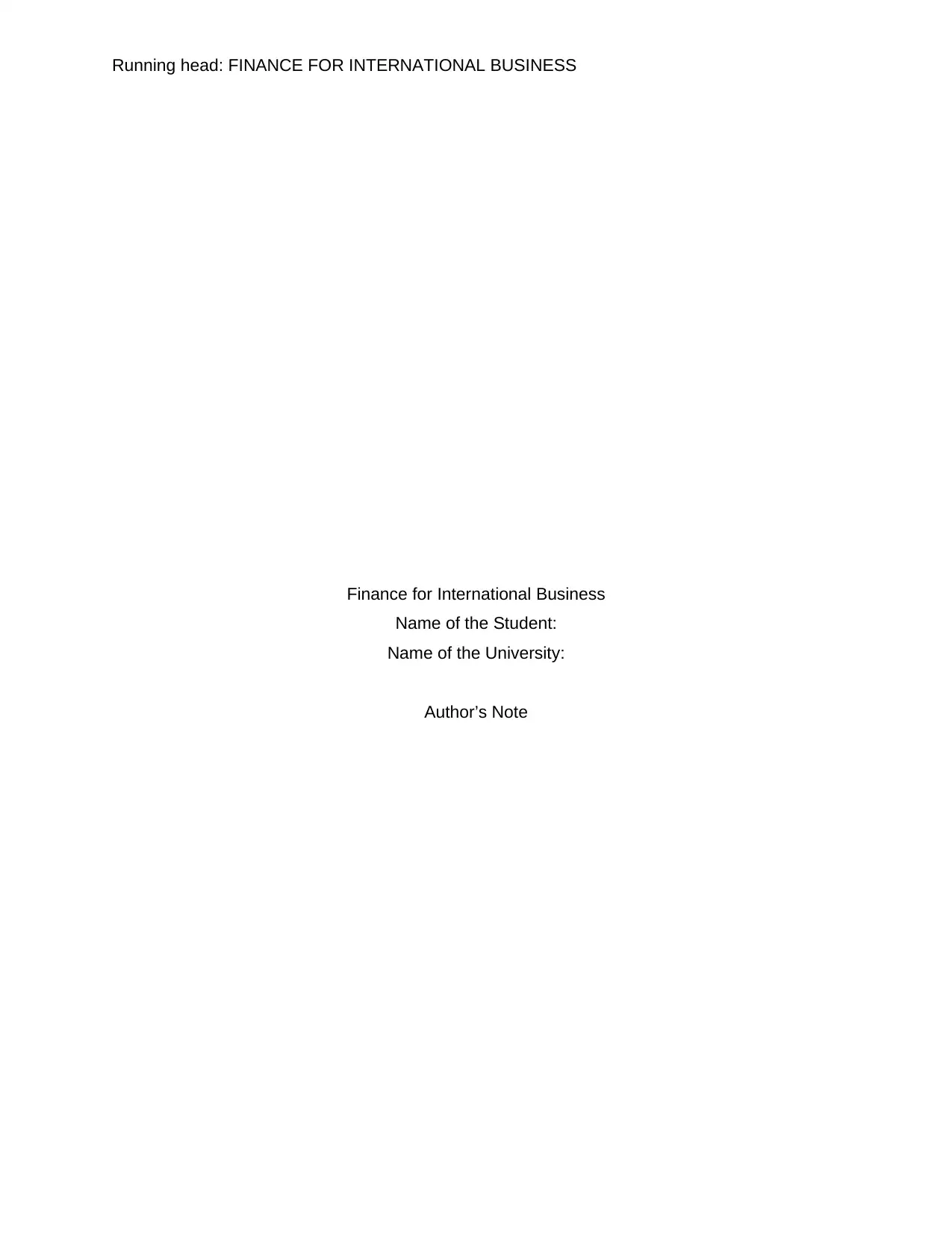
Running head: FINANCE FOR INTERNATIONAL BUSINESS
Finance for International Business
Name of the Student:
Name of the University:
Author’s Note
Finance for International Business
Name of the Student:
Name of the University:
Author’s Note
Paraphrase This Document
Need a fresh take? Get an instant paraphrase of this document with our AI Paraphraser
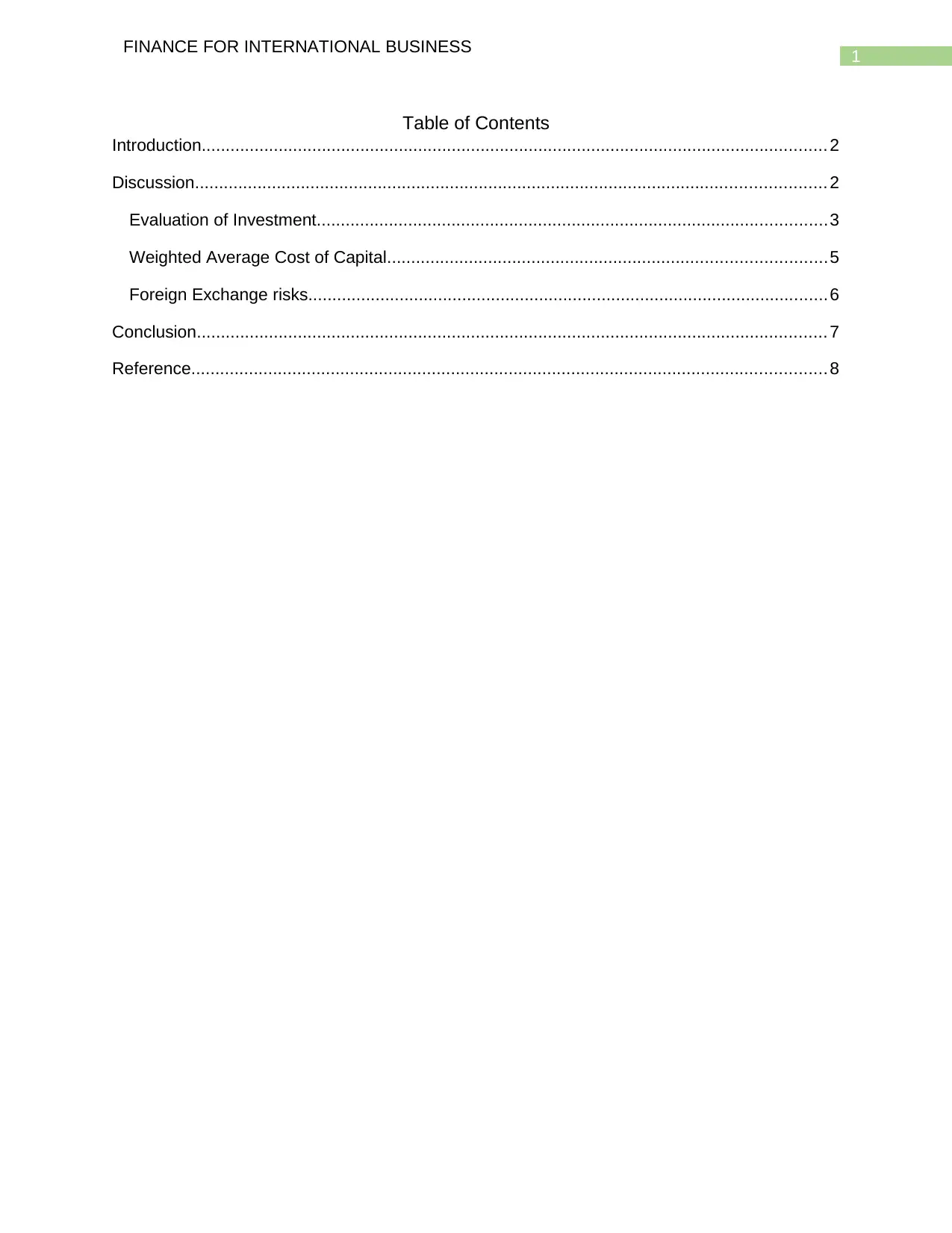
1
FINANCE FOR INTERNATIONAL BUSINESS
Table of Contents
Introduction.................................................................................................................................. 2
Discussion................................................................................................................................... 2
Evaluation of Investment..........................................................................................................3
Weighted Average Cost of Capital...........................................................................................5
Foreign Exchange risks............................................................................................................6
Conclusion................................................................................................................................... 7
Reference.................................................................................................................................... 8
FINANCE FOR INTERNATIONAL BUSINESS
Table of Contents
Introduction.................................................................................................................................. 2
Discussion................................................................................................................................... 2
Evaluation of Investment..........................................................................................................3
Weighted Average Cost of Capital...........................................................................................5
Foreign Exchange risks............................................................................................................6
Conclusion................................................................................................................................... 7
Reference.................................................................................................................................... 8
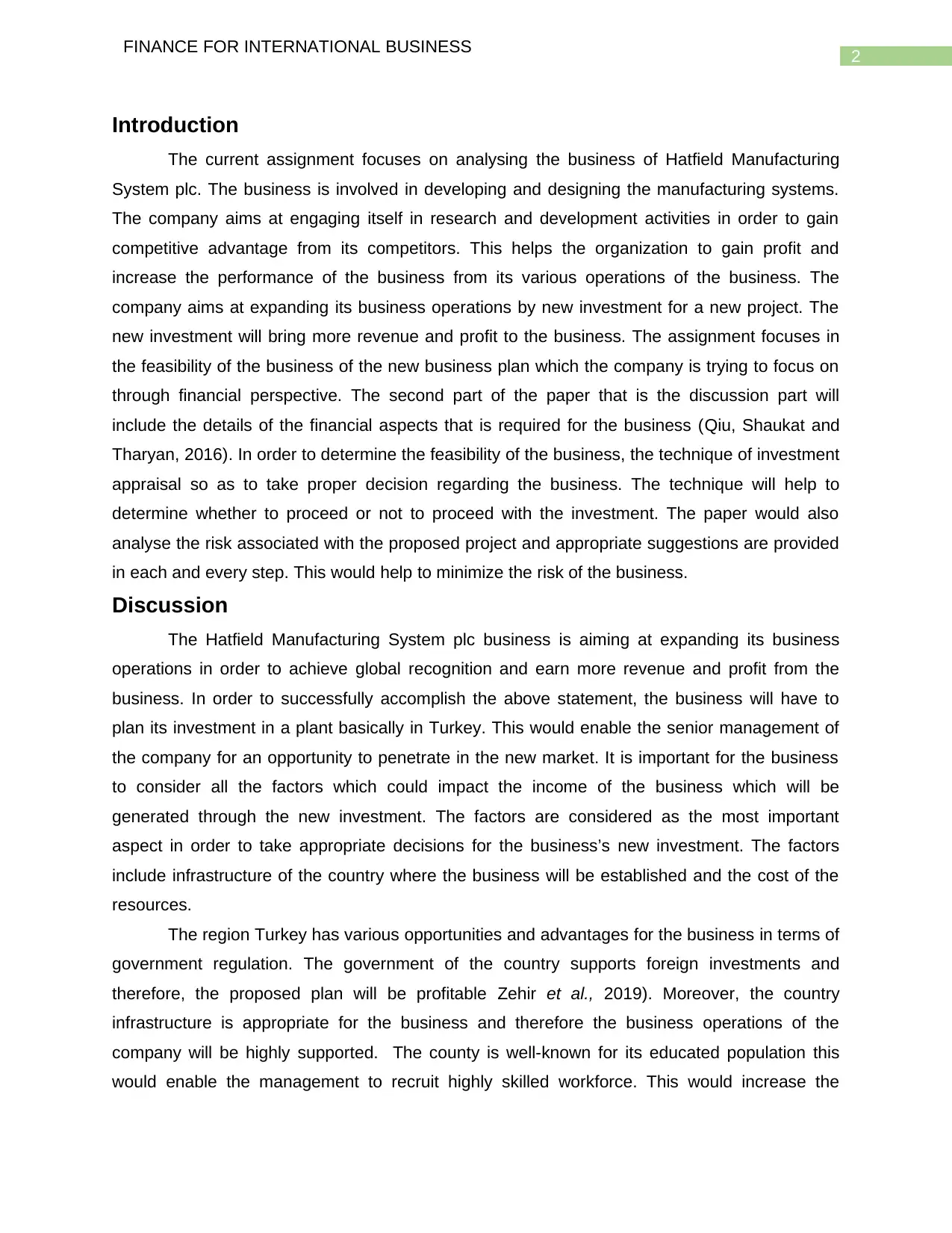
2
FINANCE FOR INTERNATIONAL BUSINESS
Introduction
The current assignment focuses on analysing the business of Hatfield Manufacturing
System plc. The business is involved in developing and designing the manufacturing systems.
The company aims at engaging itself in research and development activities in order to gain
competitive advantage from its competitors. This helps the organization to gain profit and
increase the performance of the business from its various operations of the business. The
company aims at expanding its business operations by new investment for a new project. The
new investment will bring more revenue and profit to the business. The assignment focuses in
the feasibility of the business of the new business plan which the company is trying to focus on
through financial perspective. The second part of the paper that is the discussion part will
include the details of the financial aspects that is required for the business (Qiu, Shaukat and
Tharyan, 2016). In order to determine the feasibility of the business, the technique of investment
appraisal so as to take proper decision regarding the business. The technique will help to
determine whether to proceed or not to proceed with the investment. The paper would also
analyse the risk associated with the proposed project and appropriate suggestions are provided
in each and every step. This would help to minimize the risk of the business.
Discussion
The Hatfield Manufacturing System plc business is aiming at expanding its business
operations in order to achieve global recognition and earn more revenue and profit from the
business. In order to successfully accomplish the above statement, the business will have to
plan its investment in a plant basically in Turkey. This would enable the senior management of
the company for an opportunity to penetrate in the new market. It is important for the business
to consider all the factors which could impact the income of the business which will be
generated through the new investment. The factors are considered as the most important
aspect in order to take appropriate decisions for the business’s new investment. The factors
include infrastructure of the country where the business will be established and the cost of the
resources.
The region Turkey has various opportunities and advantages for the business in terms of
government regulation. The government of the country supports foreign investments and
therefore, the proposed plan will be profitable Zehir et al., 2019). Moreover, the country
infrastructure is appropriate for the business and therefore the business operations of the
company will be highly supported. The county is well-known for its educated population this
would enable the management to recruit highly skilled workforce. This would increase the
FINANCE FOR INTERNATIONAL BUSINESS
Introduction
The current assignment focuses on analysing the business of Hatfield Manufacturing
System plc. The business is involved in developing and designing the manufacturing systems.
The company aims at engaging itself in research and development activities in order to gain
competitive advantage from its competitors. This helps the organization to gain profit and
increase the performance of the business from its various operations of the business. The
company aims at expanding its business operations by new investment for a new project. The
new investment will bring more revenue and profit to the business. The assignment focuses in
the feasibility of the business of the new business plan which the company is trying to focus on
through financial perspective. The second part of the paper that is the discussion part will
include the details of the financial aspects that is required for the business (Qiu, Shaukat and
Tharyan, 2016). In order to determine the feasibility of the business, the technique of investment
appraisal so as to take proper decision regarding the business. The technique will help to
determine whether to proceed or not to proceed with the investment. The paper would also
analyse the risk associated with the proposed project and appropriate suggestions are provided
in each and every step. This would help to minimize the risk of the business.
Discussion
The Hatfield Manufacturing System plc business is aiming at expanding its business
operations in order to achieve global recognition and earn more revenue and profit from the
business. In order to successfully accomplish the above statement, the business will have to
plan its investment in a plant basically in Turkey. This would enable the senior management of
the company for an opportunity to penetrate in the new market. It is important for the business
to consider all the factors which could impact the income of the business which will be
generated through the new investment. The factors are considered as the most important
aspect in order to take appropriate decisions for the business’s new investment. The factors
include infrastructure of the country where the business will be established and the cost of the
resources.
The region Turkey has various opportunities and advantages for the business in terms of
government regulation. The government of the country supports foreign investments and
therefore, the proposed plan will be profitable Zehir et al., 2019). Moreover, the country
infrastructure is appropriate for the business and therefore the business operations of the
company will be highly supported. The county is well-known for its educated population this
would enable the management to recruit highly skilled workforce. This would increase the
⊘ This is a preview!⊘
Do you want full access?
Subscribe today to unlock all pages.

Trusted by 1+ million students worldwide
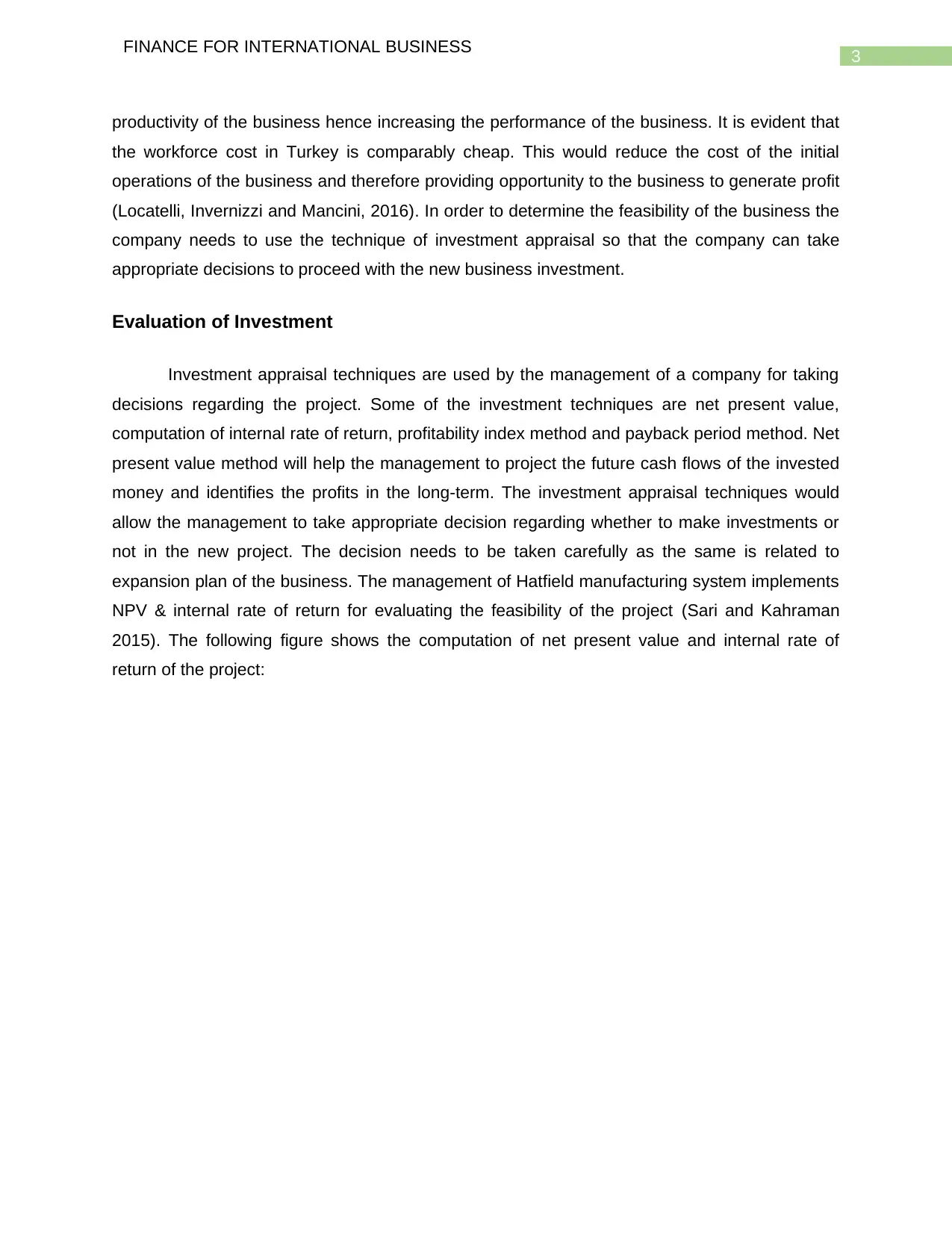
3
FINANCE FOR INTERNATIONAL BUSINESS
productivity of the business hence increasing the performance of the business. It is evident that
the workforce cost in Turkey is comparably cheap. This would reduce the cost of the initial
operations of the business and therefore providing opportunity to the business to generate profit
(Locatelli, Invernizzi and Mancini, 2016). In order to determine the feasibility of the business the
company needs to use the technique of investment appraisal so that the company can take
appropriate decisions to proceed with the new business investment.
Evaluation of Investment
Investment appraisal techniques are used by the management of a company for taking
decisions regarding the project. Some of the investment techniques are net present value,
computation of internal rate of return, profitability index method and payback period method. Net
present value method will help the management to project the future cash flows of the invested
money and identifies the profits in the long-term. The investment appraisal techniques would
allow the management to take appropriate decision regarding whether to make investments or
not in the new project. The decision needs to be taken carefully as the same is related to
expansion plan of the business. The management of Hatfield manufacturing system implements
NPV & internal rate of return for evaluating the feasibility of the project (Sari and Kahraman
2015). The following figure shows the computation of net present value and internal rate of
return of the project:
FINANCE FOR INTERNATIONAL BUSINESS
productivity of the business hence increasing the performance of the business. It is evident that
the workforce cost in Turkey is comparably cheap. This would reduce the cost of the initial
operations of the business and therefore providing opportunity to the business to generate profit
(Locatelli, Invernizzi and Mancini, 2016). In order to determine the feasibility of the business the
company needs to use the technique of investment appraisal so that the company can take
appropriate decisions to proceed with the new business investment.
Evaluation of Investment
Investment appraisal techniques are used by the management of a company for taking
decisions regarding the project. Some of the investment techniques are net present value,
computation of internal rate of return, profitability index method and payback period method. Net
present value method will help the management to project the future cash flows of the invested
money and identifies the profits in the long-term. The investment appraisal techniques would
allow the management to take appropriate decision regarding whether to make investments or
not in the new project. The decision needs to be taken carefully as the same is related to
expansion plan of the business. The management of Hatfield manufacturing system implements
NPV & internal rate of return for evaluating the feasibility of the project (Sari and Kahraman
2015). The following figure shows the computation of net present value and internal rate of
return of the project:
Paraphrase This Document
Need a fresh take? Get an instant paraphrase of this document with our AI Paraphraser
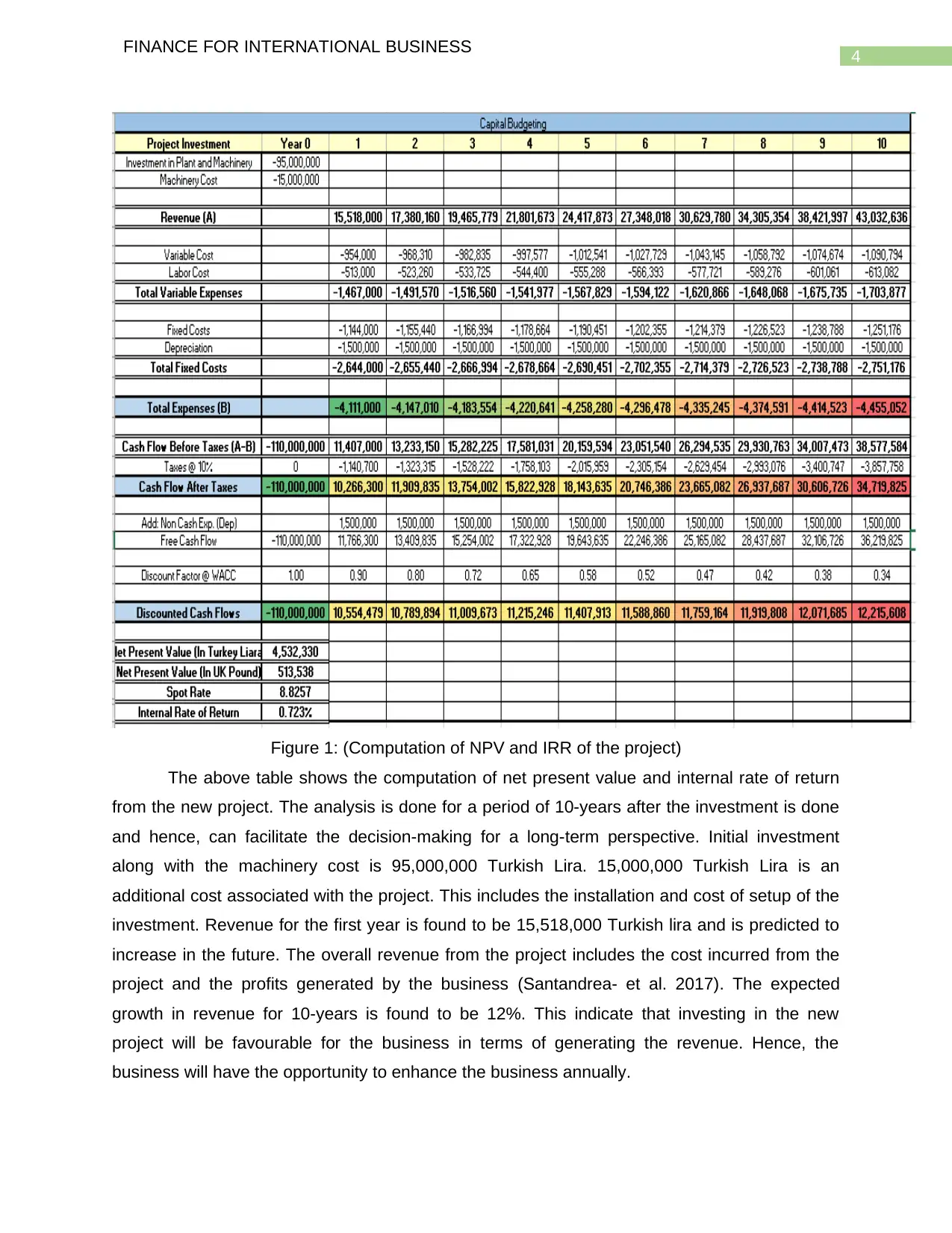
4
FINANCE FOR INTERNATIONAL BUSINESS
Figure 1: (Computation of NPV and IRR of the project)
The above table shows the computation of net present value and internal rate of return
from the new project. The analysis is done for a period of 10-years after the investment is done
and hence, can facilitate the decision-making for a long-term perspective. Initial investment
along with the machinery cost is 95,000,000 Turkish Lira. 15,000,000 Turkish Lira is an
additional cost associated with the project. This includes the installation and cost of setup of the
investment. Revenue for the first year is found to be 15,518,000 Turkish lira and is predicted to
increase in the future. The overall revenue from the project includes the cost incurred from the
project and the profits generated by the business (Santandrea- et al. 2017). The expected
growth in revenue for 10-years is found to be 12%. This indicate that investing in the new
project will be favourable for the business in terms of generating the revenue. Hence, the
business will have the opportunity to enhance the business annually.
FINANCE FOR INTERNATIONAL BUSINESS
Figure 1: (Computation of NPV and IRR of the project)
The above table shows the computation of net present value and internal rate of return
from the new project. The analysis is done for a period of 10-years after the investment is done
and hence, can facilitate the decision-making for a long-term perspective. Initial investment
along with the machinery cost is 95,000,000 Turkish Lira. 15,000,000 Turkish Lira is an
additional cost associated with the project. This includes the installation and cost of setup of the
investment. Revenue for the first year is found to be 15,518,000 Turkish lira and is predicted to
increase in the future. The overall revenue from the project includes the cost incurred from the
project and the profits generated by the business (Santandrea- et al. 2017). The expected
growth in revenue for 10-years is found to be 12%. This indicate that investing in the new
project will be favourable for the business in terms of generating the revenue. Hence, the
business will have the opportunity to enhance the business annually.
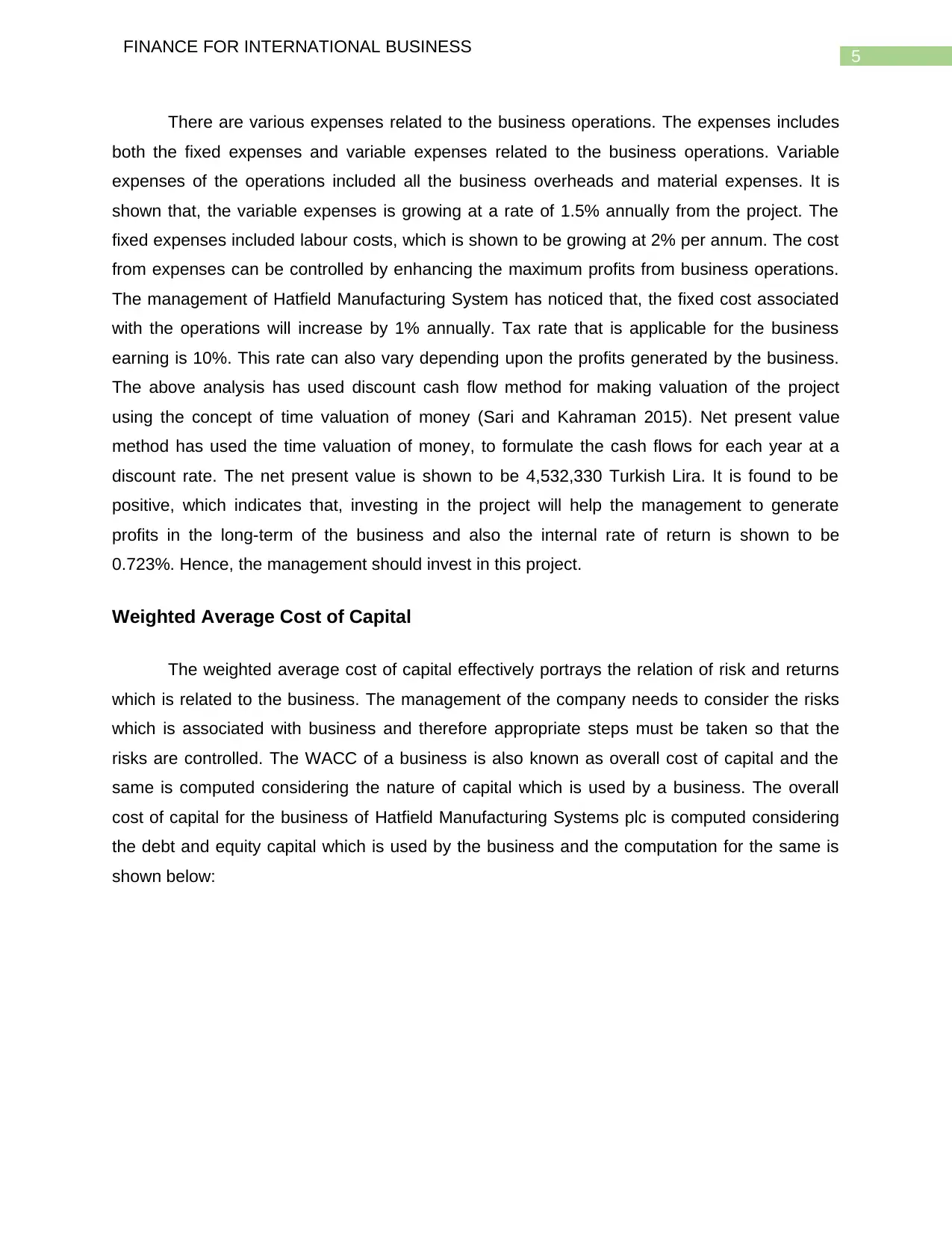
5
FINANCE FOR INTERNATIONAL BUSINESS
There are various expenses related to the business operations. The expenses includes
both the fixed expenses and variable expenses related to the business operations. Variable
expenses of the operations included all the business overheads and material expenses. It is
shown that, the variable expenses is growing at a rate of 1.5% annually from the project. The
fixed expenses included labour costs, which is shown to be growing at 2% per annum. The cost
from expenses can be controlled by enhancing the maximum profits from business operations.
The management of Hatfield Manufacturing System has noticed that, the fixed cost associated
with the operations will increase by 1% annually. Tax rate that is applicable for the business
earning is 10%. This rate can also vary depending upon the profits generated by the business.
The above analysis has used discount cash flow method for making valuation of the project
using the concept of time valuation of money (Sari and Kahraman 2015). Net present value
method has used the time valuation of money, to formulate the cash flows for each year at a
discount rate. The net present value is shown to be 4,532,330 Turkish Lira. It is found to be
positive, which indicates that, investing in the project will help the management to generate
profits in the long-term of the business and also the internal rate of return is shown to be
0.723%. Hence, the management should invest in this project.
Weighted Average Cost of Capital
The weighted average cost of capital effectively portrays the relation of risk and returns
which is related to the business. The management of the company needs to consider the risks
which is associated with business and therefore appropriate steps must be taken so that the
risks are controlled. The WACC of a business is also known as overall cost of capital and the
same is computed considering the nature of capital which is used by a business. The overall
cost of capital for the business of Hatfield Manufacturing Systems plc is computed considering
the debt and equity capital which is used by the business and the computation for the same is
shown below:
FINANCE FOR INTERNATIONAL BUSINESS
There are various expenses related to the business operations. The expenses includes
both the fixed expenses and variable expenses related to the business operations. Variable
expenses of the operations included all the business overheads and material expenses. It is
shown that, the variable expenses is growing at a rate of 1.5% annually from the project. The
fixed expenses included labour costs, which is shown to be growing at 2% per annum. The cost
from expenses can be controlled by enhancing the maximum profits from business operations.
The management of Hatfield Manufacturing System has noticed that, the fixed cost associated
with the operations will increase by 1% annually. Tax rate that is applicable for the business
earning is 10%. This rate can also vary depending upon the profits generated by the business.
The above analysis has used discount cash flow method for making valuation of the project
using the concept of time valuation of money (Sari and Kahraman 2015). Net present value
method has used the time valuation of money, to formulate the cash flows for each year at a
discount rate. The net present value is shown to be 4,532,330 Turkish Lira. It is found to be
positive, which indicates that, investing in the project will help the management to generate
profits in the long-term of the business and also the internal rate of return is shown to be
0.723%. Hence, the management should invest in this project.
Weighted Average Cost of Capital
The weighted average cost of capital effectively portrays the relation of risk and returns
which is related to the business. The management of the company needs to consider the risks
which is associated with business and therefore appropriate steps must be taken so that the
risks are controlled. The WACC of a business is also known as overall cost of capital and the
same is computed considering the nature of capital which is used by a business. The overall
cost of capital for the business of Hatfield Manufacturing Systems plc is computed considering
the debt and equity capital which is used by the business and the computation for the same is
shown below:
⊘ This is a preview!⊘
Do you want full access?
Subscribe today to unlock all pages.

Trusted by 1+ million students worldwide
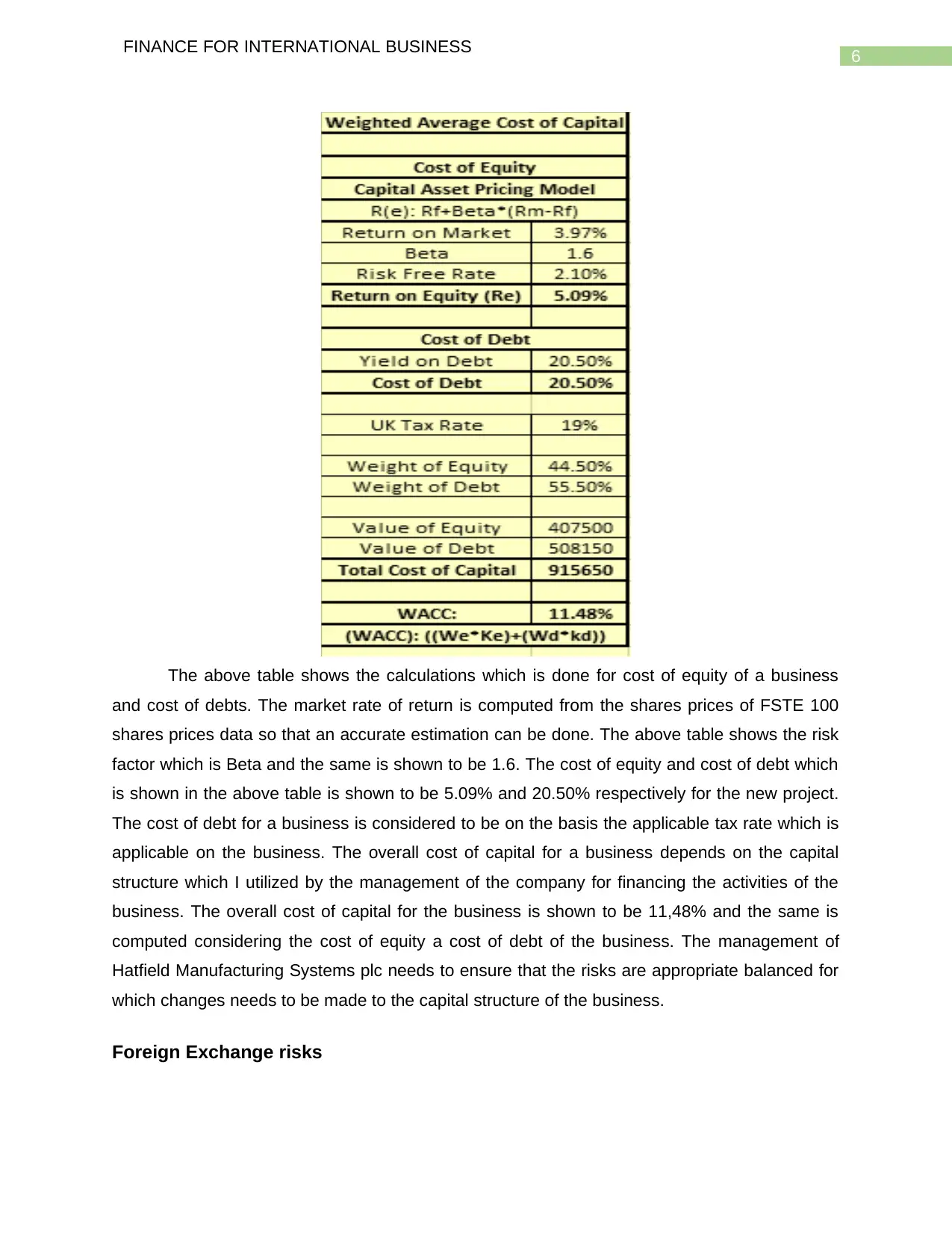
6
FINANCE FOR INTERNATIONAL BUSINESS
The above table shows the calculations which is done for cost of equity of a business
and cost of debts. The market rate of return is computed from the shares prices of FSTE 100
shares prices data so that an accurate estimation can be done. The above table shows the risk
factor which is Beta and the same is shown to be 1.6. The cost of equity and cost of debt which
is shown in the above table is shown to be 5.09% and 20.50% respectively for the new project.
The cost of debt for a business is considered to be on the basis the applicable tax rate which is
applicable on the business. The overall cost of capital for a business depends on the capital
structure which I utilized by the management of the company for financing the activities of the
business. The overall cost of capital for the business is shown to be 11,48% and the same is
computed considering the cost of equity a cost of debt of the business. The management of
Hatfield Manufacturing Systems plc needs to ensure that the risks are appropriate balanced for
which changes needs to be made to the capital structure of the business.
Foreign Exchange risks
FINANCE FOR INTERNATIONAL BUSINESS
The above table shows the calculations which is done for cost of equity of a business
and cost of debts. The market rate of return is computed from the shares prices of FSTE 100
shares prices data so that an accurate estimation can be done. The above table shows the risk
factor which is Beta and the same is shown to be 1.6. The cost of equity and cost of debt which
is shown in the above table is shown to be 5.09% and 20.50% respectively for the new project.
The cost of debt for a business is considered to be on the basis the applicable tax rate which is
applicable on the business. The overall cost of capital for a business depends on the capital
structure which I utilized by the management of the company for financing the activities of the
business. The overall cost of capital for the business is shown to be 11,48% and the same is
computed considering the cost of equity a cost of debt of the business. The management of
Hatfield Manufacturing Systems plc needs to ensure that the risks are appropriate balanced for
which changes needs to be made to the capital structure of the business.
Foreign Exchange risks
Paraphrase This Document
Need a fresh take? Get an instant paraphrase of this document with our AI Paraphraser
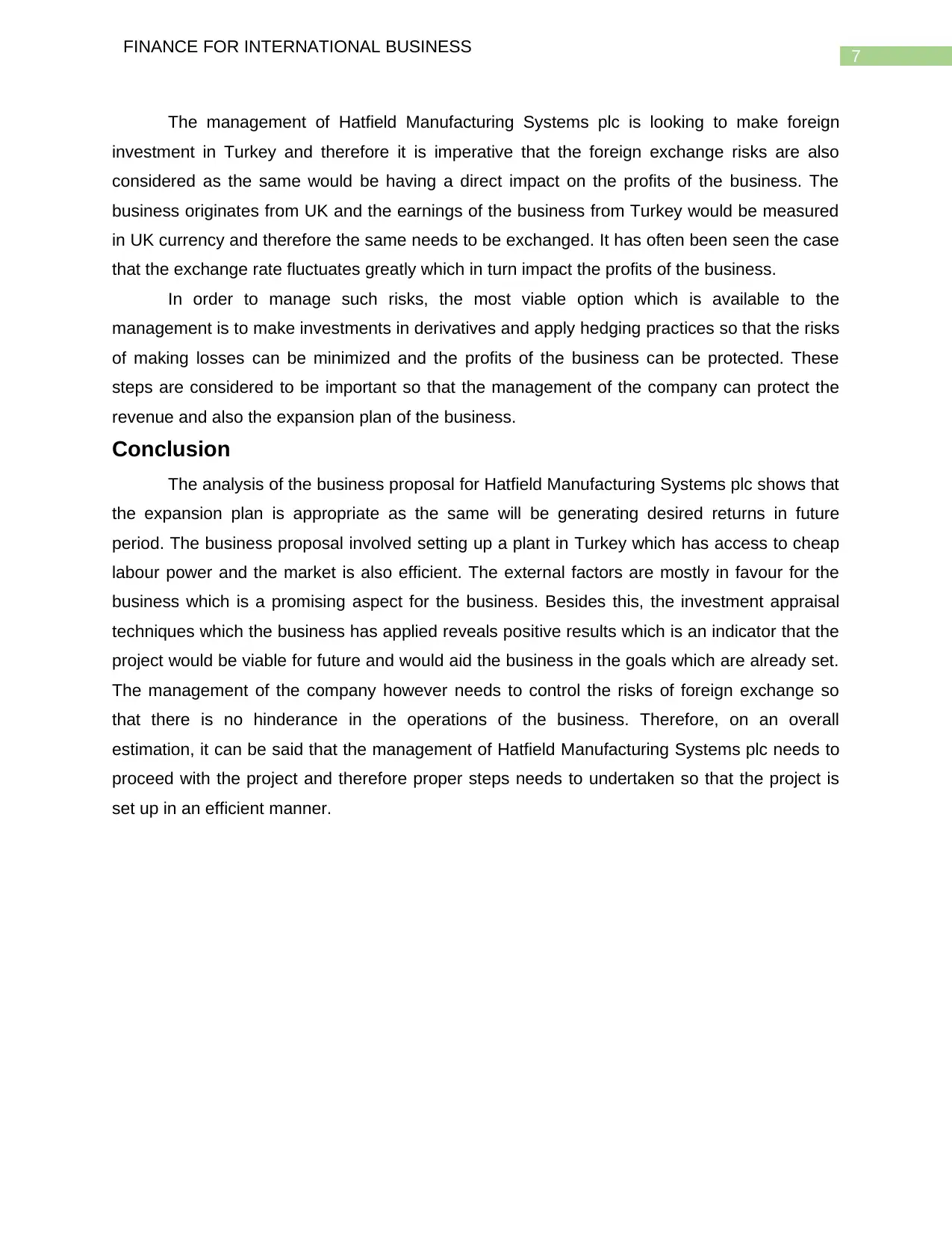
7
FINANCE FOR INTERNATIONAL BUSINESS
The management of Hatfield Manufacturing Systems plc is looking to make foreign
investment in Turkey and therefore it is imperative that the foreign exchange risks are also
considered as the same would be having a direct impact on the profits of the business. The
business originates from UK and the earnings of the business from Turkey would be measured
in UK currency and therefore the same needs to be exchanged. It has often been seen the case
that the exchange rate fluctuates greatly which in turn impact the profits of the business.
In order to manage such risks, the most viable option which is available to the
management is to make investments in derivatives and apply hedging practices so that the risks
of making losses can be minimized and the profits of the business can be protected. These
steps are considered to be important so that the management of the company can protect the
revenue and also the expansion plan of the business.
Conclusion
The analysis of the business proposal for Hatfield Manufacturing Systems plc shows that
the expansion plan is appropriate as the same will be generating desired returns in future
period. The business proposal involved setting up a plant in Turkey which has access to cheap
labour power and the market is also efficient. The external factors are mostly in favour for the
business which is a promising aspect for the business. Besides this, the investment appraisal
techniques which the business has applied reveals positive results which is an indicator that the
project would be viable for future and would aid the business in the goals which are already set.
The management of the company however needs to control the risks of foreign exchange so
that there is no hinderance in the operations of the business. Therefore, on an overall
estimation, it can be said that the management of Hatfield Manufacturing Systems plc needs to
proceed with the project and therefore proper steps needs to undertaken so that the project is
set up in an efficient manner.
FINANCE FOR INTERNATIONAL BUSINESS
The management of Hatfield Manufacturing Systems plc is looking to make foreign
investment in Turkey and therefore it is imperative that the foreign exchange risks are also
considered as the same would be having a direct impact on the profits of the business. The
business originates from UK and the earnings of the business from Turkey would be measured
in UK currency and therefore the same needs to be exchanged. It has often been seen the case
that the exchange rate fluctuates greatly which in turn impact the profits of the business.
In order to manage such risks, the most viable option which is available to the
management is to make investments in derivatives and apply hedging practices so that the risks
of making losses can be minimized and the profits of the business can be protected. These
steps are considered to be important so that the management of the company can protect the
revenue and also the expansion plan of the business.
Conclusion
The analysis of the business proposal for Hatfield Manufacturing Systems plc shows that
the expansion plan is appropriate as the same will be generating desired returns in future
period. The business proposal involved setting up a plant in Turkey which has access to cheap
labour power and the market is also efficient. The external factors are mostly in favour for the
business which is a promising aspect for the business. Besides this, the investment appraisal
techniques which the business has applied reveals positive results which is an indicator that the
project would be viable for future and would aid the business in the goals which are already set.
The management of the company however needs to control the risks of foreign exchange so
that there is no hinderance in the operations of the business. Therefore, on an overall
estimation, it can be said that the management of Hatfield Manufacturing Systems plc needs to
proceed with the project and therefore proper steps needs to undertaken so that the project is
set up in an efficient manner.
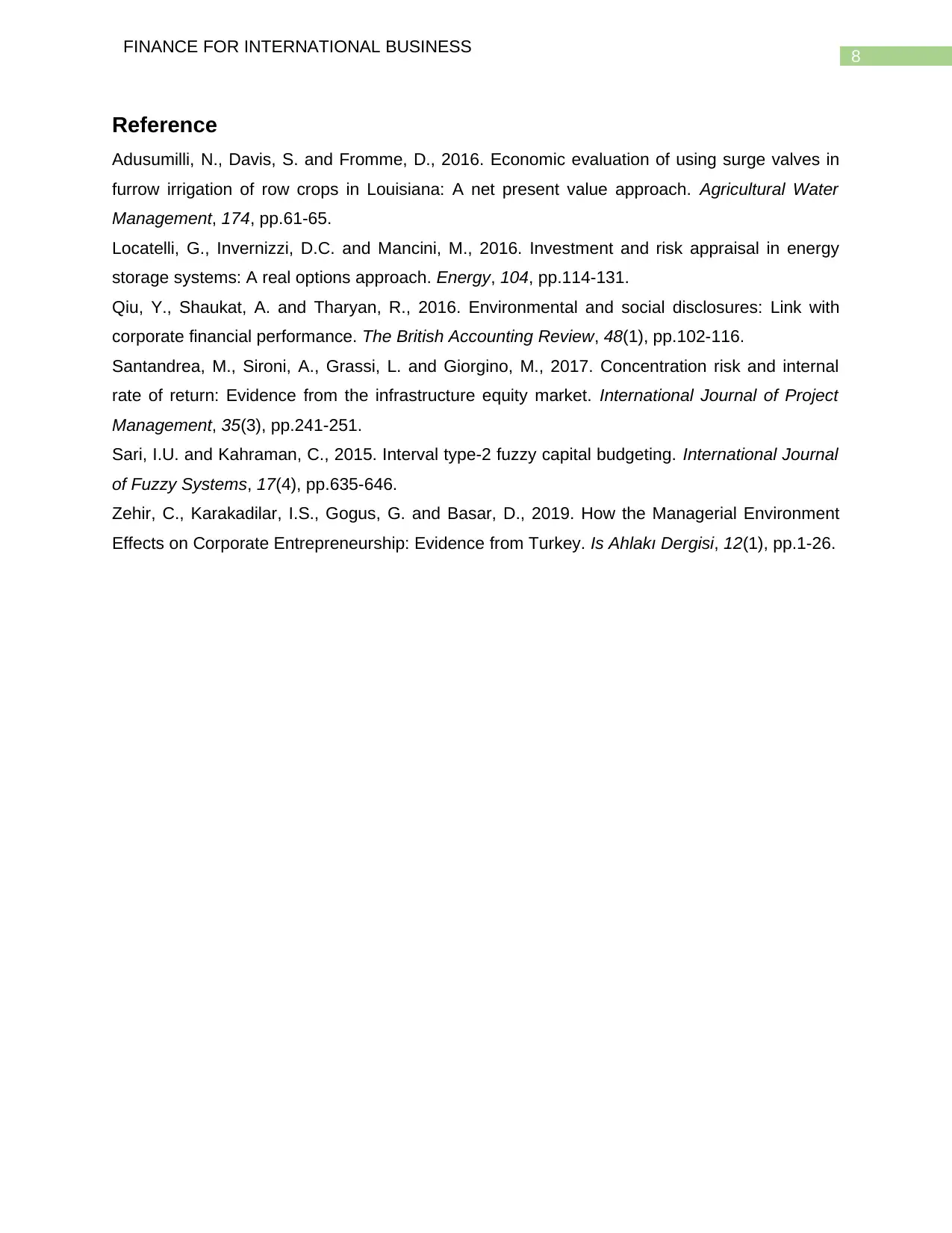
8
FINANCE FOR INTERNATIONAL BUSINESS
Reference
Adusumilli, N., Davis, S. and Fromme, D., 2016. Economic evaluation of using surge valves in
furrow irrigation of row crops in Louisiana: A net present value approach. Agricultural Water
Management, 174, pp.61-65.
Locatelli, G., Invernizzi, D.C. and Mancini, M., 2016. Investment and risk appraisal in energy
storage systems: A real options approach. Energy, 104, pp.114-131.
Qiu, Y., Shaukat, A. and Tharyan, R., 2016. Environmental and social disclosures: Link with
corporate financial performance. The British Accounting Review, 48(1), pp.102-116.
Santandrea, M., Sironi, A., Grassi, L. and Giorgino, M., 2017. Concentration risk and internal
rate of return: Evidence from the infrastructure equity market. International Journal of Project
Management, 35(3), pp.241-251.
Sari, I.U. and Kahraman, C., 2015. Interval type-2 fuzzy capital budgeting. International Journal
of Fuzzy Systems, 17(4), pp.635-646.
Zehir, C., Karakadilar, I.S., Gogus, G. and Basar, D., 2019. How the Managerial Environment
Effects on Corporate Entrepreneurship: Evidence from Turkey. Is Ahlakı Dergisi, 12(1), pp.1-26.
FINANCE FOR INTERNATIONAL BUSINESS
Reference
Adusumilli, N., Davis, S. and Fromme, D., 2016. Economic evaluation of using surge valves in
furrow irrigation of row crops in Louisiana: A net present value approach. Agricultural Water
Management, 174, pp.61-65.
Locatelli, G., Invernizzi, D.C. and Mancini, M., 2016. Investment and risk appraisal in energy
storage systems: A real options approach. Energy, 104, pp.114-131.
Qiu, Y., Shaukat, A. and Tharyan, R., 2016. Environmental and social disclosures: Link with
corporate financial performance. The British Accounting Review, 48(1), pp.102-116.
Santandrea, M., Sironi, A., Grassi, L. and Giorgino, M., 2017. Concentration risk and internal
rate of return: Evidence from the infrastructure equity market. International Journal of Project
Management, 35(3), pp.241-251.
Sari, I.U. and Kahraman, C., 2015. Interval type-2 fuzzy capital budgeting. International Journal
of Fuzzy Systems, 17(4), pp.635-646.
Zehir, C., Karakadilar, I.S., Gogus, G. and Basar, D., 2019. How the Managerial Environment
Effects on Corporate Entrepreneurship: Evidence from Turkey. Is Ahlakı Dergisi, 12(1), pp.1-26.
⊘ This is a preview!⊘
Do you want full access?
Subscribe today to unlock all pages.

Trusted by 1+ million students worldwide
1 out of 9
Related Documents
Your All-in-One AI-Powered Toolkit for Academic Success.
+13062052269
info@desklib.com
Available 24*7 on WhatsApp / Email
![[object Object]](/_next/static/media/star-bottom.7253800d.svg)
Unlock your academic potential
Copyright © 2020–2025 A2Z Services. All Rights Reserved. Developed and managed by ZUCOL.





